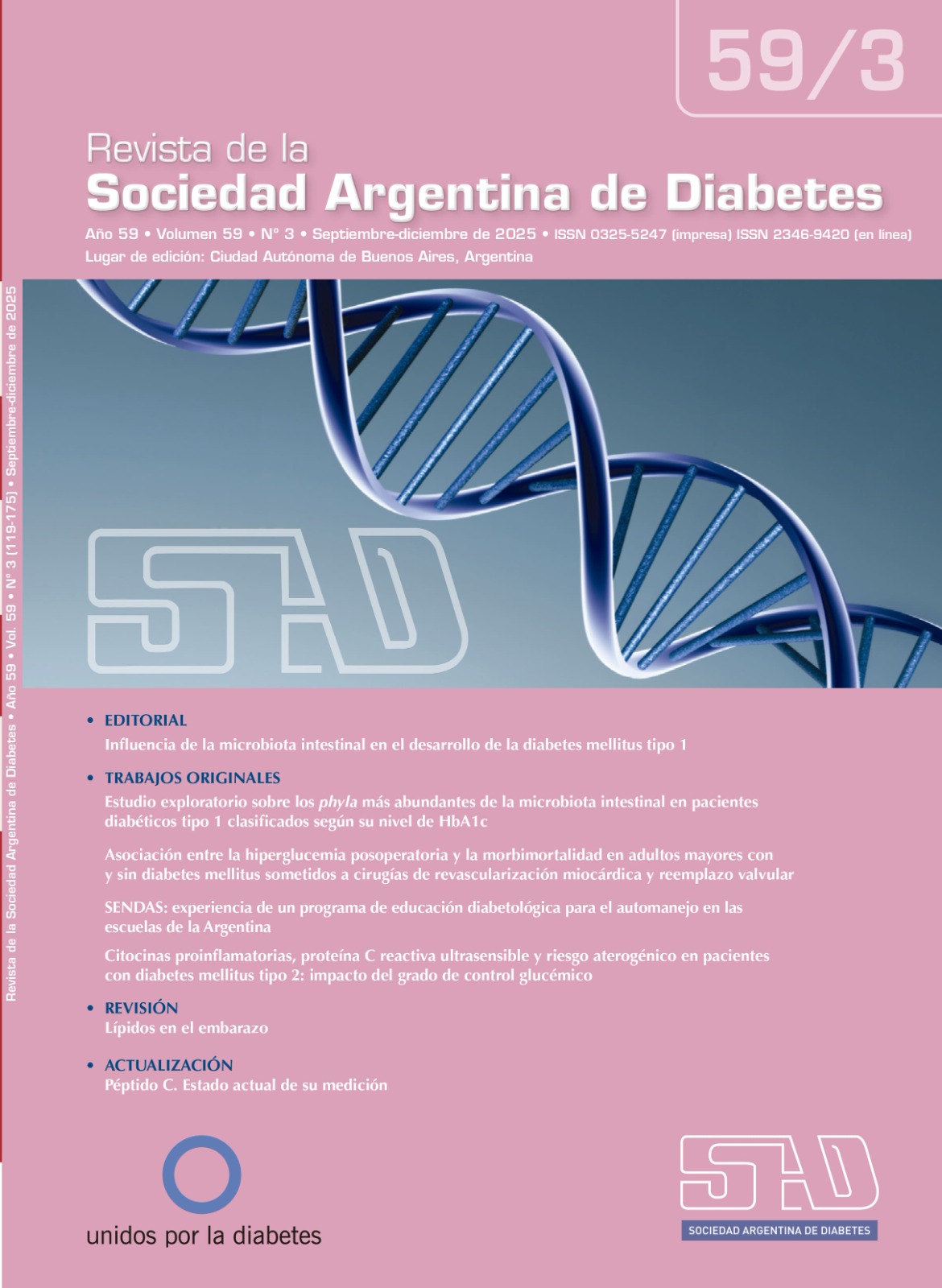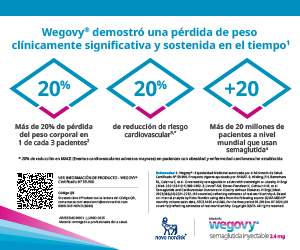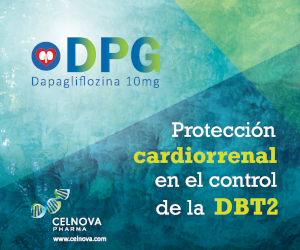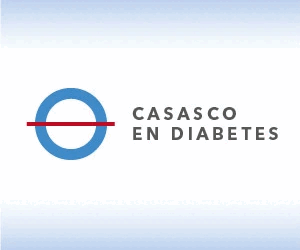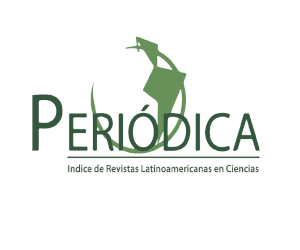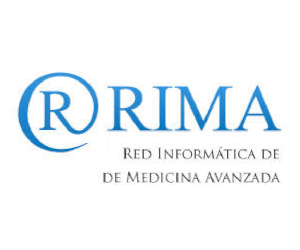Estudio exploratorio sobre los phyla más abundantes de la microbiota intestinal en pacientes diabéticos tipo 1 clasificados según su nivel de HbA1c
DOI:
https://doi.org/10.47196/diab.v59i3.1274Palabras clave:
diabetes mellitus tipo 1, microbiota, control glucémicoResumen
Introducción: la diabetes mellitus tipo 1 (DM1) se caracteriza por la destrucción de las células β del páncreas. La microbiota es el conjunto de microorganismos (comensales, simbióticos y patógenos) que colonizan el organismo. Recientemente se describió la participación de la microbiota en la DM y una diferente composición microbiana en pacientes con DM1 con buen control glucémico versus aquellos que no lo tienen. Por otro lado, la mayoría de los estudios de microbiota se realizó en países industrializados, lo que muestra una falta de datos provenientes de nuestro país.
Objetivos: se realizó un estudio transversal para determinar la composición microbiana a través del estudio de los phyla más abundantes en pacientes con DM1 según sus niveles de HbA1c y en individuos control del área metropolitana de Buenos Aires.
Materiales y métodos: se reclutaron voluntarios no obesos con o sin DM1, mayores de 18 años del Servicio de Endocrinología, Metabolismo, Nutrición y Diabetes del Hospital Británico de Buenos Aires. Se obtuvieron las variables demográficas, medidas antropométricas, datos de laboratorio y fue entregada la correspondiente muestra de materia fecal. La composición microbiana se determinó por PCR en tiempo real utilizando primers específicos para los phyla más abundantes de la microbiota.
Resultados: los resultados mostraron mayores niveles de Actinobacteria para el grupo diabético con mal control glucémico (p<0,05), sin encontrarse cambios significativos en los niveles de Bacteroidetes, Firmicutes y Proteobacteria. Asimismo, al analizar la correlación entre los resultados y los niveles de HbA1c en los individuos con DM1, se hallaron correlaciones positivas con Bacteroidetes, Actinobacteria y negativa con la relación Firmicutes/Bacteroidetes.
Conclusiones: existen alteraciones en la microbiota de los pacientes con DM1. Se han establecido relaciones entre la microbiota y la HbA1c. De acuerdo con la literatura, resultados similares se obtuvieron en ensayos realizados en otras poblaciones.
Citas
I. Gregory GA, Robinson TIG, Linklater SE, et al. Global incidence, prevalence, and mortality of type 1 diabetes in 2021 with projection to 2040: a modelling study. Lancet Diabetes Endocrinol 2022;10(10):741-760. doi:10.1016/S2213-8587(22)00218-2
II. International Diabetes Federation. IDF Diabetes Atlas 9th ed. (Williams R, Colagiuri S, Almutairi R, et al., eds.). International Diabetes Federation; 2019.
III. American Diabetes Association. Professional Practice Committee. 6. Glycemic goals and hypoglycemia. Standards of Care in Diabetes-2024. Diabetes Care. 2024;47(Suppl 1):S111-S125. doi:10.2337/dc24-S006.
IV. Ley RE, Peterson DA, Gordon JI. Ecological and evolutionary forces shaping microbial diversity in the human intestine. Cell 2006;124(4):837-848. doi:10.1016/j.cell.2006.02.017.
V. Ley RE, Lozupone CA, Hamady M, Knight R, Gordon JI. Worlds within worlds: evolution of the vertebrate gut microbiota. Nat Rev Microbiol 2008;6(10):776-788. doi:10.1038/nrmicro1978.
VI. Maslowski KM, Mackay CR. Diet, gut microbiota and immune responses. Nat Immunol 2011;12(1):5-9. doi:10.1038/ni0111-5.
VII. Durack J, Lynch SV. The gut microbiome: relationships with disease and opportunities for therapy. J Exp Med 2019;216(1):20-40. doi:10.1084/jem.20180448.
VIII. Yao Y, Cai X, Ye Y, Wang F, Chen F, Zheng C. The role of microbiota in infant health: from early life to adulthood. Front Immunol 2021;12:708472. doi:10.3389/fimmu.2021.708472.
IX. Tremaroli V, Bäckhed F. Functional interactions between the gut microbiota and host metabolism. Nature 2012;489(7415):242-249. doi:10.1038/nature11552.
X. Robles-Alonso V, Guarner F. Linking the gut microbiota to human health. Br J Nutr 2013;109 Suppl 2:S21-6. doi:10.1017/S0007114512005235.
XI. Jandhyala SM, Talukdar R, Subramanyam C, Vuyyuru H, Sasikala M, Nageshwar Reddy D. Role of the normal gut microbiota. World J Gastroenterol 2015;21(29):8787-8803. doi:10.3748/wjg.v21.i29.8787.
XII. Molinaro F, Paschetta E, Cassader M, Gambino R, Musso G. Probiotics, prebiotics, energy balance, and obesity: mechanistic insights and therapeutic implications. Gastroenterol Clin North Am 2012;41(4):843-854. doi:10.1016/j.gtc.2012.08.009.
XIII. Donaldson GP, Lee SM, Mazmanian SK. Gut biogeography of the bacterial microbiota. Nat Rev Microbiol 2016;14(1):20-32. doi:10.1038/nrmicro3552.
XIV. Knip M, Siljander H. The role of the intestinal microbiota in type 1 diabetes mellitus. Nat Rev Endocrinol 2016;12(3):154-167. doi:10.1038/nrendo.2015.218.
XV. Paun A, Yau C, Danska JS. The influence of the microbiome on type 1 diabetes. J Immunol 2017;198(2):590-595. doi:10.4049/jimmunol.1601519.
XVI. Brown CT, Davis-Richardson AG, Giongo A, et al. Gut microbiome metagenomics analysis suggests a functional model for the development of autoimmunity for type 1 diabetes. PLoS One 2011;6(10):e25792. doi:10.1371/journal.pone.0025792.
XVII. de Goffau MC, Luopajärvi K, Knip M, et al. Fecal microbiota composition differs between children with β-cell autoimmunity and those without. Diabetes 2013;62(4):1238-1244. doi:10.2337/db12-0526.
XVIII. Jamshidi P, Hasanzadeh S, Tahvildari A, et al. Is there any association between gut microbiota and type 1 diabetes? A systematic review. Gut Pathog 2019;11:49. doi:10.1186/s13099-019-0332-7.
XIX. Ma Q, Li Y, Wang J, et al. Investigation of gut microbiome changes in type 1 diabetic mellitus rats based on high-throughput sequencing. Biomed Pharmacother 2020;124:109873. doi:10.1016/j.biopha.2020.109873.
XX. Zhou H, Sun L, Zhang S, Zhao X, Gang X, Wang G. Evaluating the causal role of gut microbiota in type 1 diabetes and its possible pathogenic mechanisms. Front Endocrinol (Lausanne) 2020;11:125. doi:10.3389/fendo.2020.00125.
XXI. Mrozinska S, Kapusta P, Gosiewski T, et al. The gut microbiota profile according to glycemic control in type 1 diabetes patients treated with personal insulin pumps. Microorganisms 2021;9(1). doi:10.3390/microorganisms9010155.
XXII. Higuchi BS, Rodrigues N, Gonzaga MI, et al. Intestinal dysbiosis in autoimmune diabetes is correlated with poor glycemic control and increased interleukin-6. A pilot study. Front Immunol 2018;9:1689. doi:10.3389/fimmu.2018.01689.
XXIII. Xie Y-C, Jing X-B, Chen X, Chen L-Z, Zhang S-H, Cai X-B. Fecal microbiota transplantation treatment for type 1 diabetes mellitus with malnutrition: a case report. Ther Adv Chronic Dis 2022;13:20406223221117449. doi:10.1177/20406223221117449.
XXIV. Moreira LAA, da Paz Lima L, Aparecida de Oliveira Falcão M, Rosado EL. Profile of gut microbiota of adults with diabetes mellitus type 1. A systematic review. Curr Diabetes Rev 2022. doi:10.2174/1573399818666220328150044.
XXV. Wang C-H, Yen H-R, Lu W-L, et al. Adjuvant probiotics of Lactobacillus salivarius subsp. salicinius AP-32, L. johnsonii MH-68, and Bifidobacterium animalis subsp. lactis CP-9 attenuate glycemic levels and inflammatory cytokines in patients with type 1 diabetes mellitus. Front Endocrinol (Lausanne) 2022;13:754401. doi:10.3389/fendo.2022.754401.
XXVI. Zare Javid A, Aminzadeh M, Haghighi-Zadeh MH, Jamalvandi M. The effects of synbiotic supplementation on glycemic status, lipid profile, and biomarkers of oxidative stress in type 1 diabetic patients. A placebo-controlled, double-blind, randomized clinical trial. Diabetes Metab Syndr Obes 2020;13:607-617. doi:10.2147/DMSO.S238867.
XXVII. Shabani-Mirzaee H, Haghshenas Z, Malekiantaghi A, Vigeh M, Mahdavi F, Eftekhari K. The effect of oral probiotics on glycated haemoglobin levels in children with type 1 diabetes mellitus. A randomized clinical trial. Pediatr Endocrinol Diabetes Metab 2023;29(3):128-133. doi:10.5114/pedm.2023.132025.
XXVIII. Groele L, Szajewska H, Szalecki M, et al. Lack of effect of Lactobacillus rhamnosus GG and Bifidobacterium lactis Bb12 on beta-cell function in children with newly diagnosed type 1 diabetes: a randomised controlled trial. BMJ Open Diabetes Res Care 2021;9(1). doi:10.1136/bmjdrc-2020-001523.
XXIX. Abdill RJ, Adamowicz EM, Blekhman R. Public human microbiome data are dominated by highly developed countries. PLoS Biol 2022;20(2):e3001536. doi:10.1371/journal.pbio.3001536.
XXX. American Diabetes Association Professional Practice Committee. 2. Classification and diagnosis of diabetes: Standards of Medical Care in Diabetes 2022. Diabetes Care 2022;45(Suppl 1):S17-S38. doi:10.2337/dc22-S002.
XXXI. Pischon T. Use of obesity biomarkers in cardiovascular epidemiology. Dis Markers 2009;26(5-6):247-263. doi:10.3233/DMA-2009-0634.
XXXII. Gray MA, Pratte ZA, Kellogg CA. Comparison of DNA preservation methods for environmental bacterial community samples. FEMS Microbiol Ecol 2013;83(2):468-477. doi:10.1111/1574-6941.12008.
XXXIII. Rubinstein MR, Wang X, Liu W, Hao Y, Cai G, Han YW. Fusobacterium nucleatum promotes colorectal carcinogenesis by modulating E-cadherin/β-catenin signaling via its FadA adhesin. Cell Host Microbe. 2013;14(2):195-206. doi:10.1016/j.chom.2013.07.012.
XXXIV. Gokduman K, Avsaroglu MD, Cakiris A, Ustek D, Gurakan GC. Recombinant plasmid-based quantitative Real-Time PCR analysis of Salmonella enterica serotypes and its application to milk samples. J Microbiol Methods 2016;122:50-58. doi:10.1016/j.mimet.2016.01.008.
XXXV. Arumugam M, Raes J, Pelletier E, et al. Enterotypes of the human gut microbiome. Nature 2011;473(7346):174-180. doi:10.1038/nature09944.
XXXVI. Bornet E, Westermann AJ. The ambivalent role of Bacteroides in enteric infections. Trends Microbiol 2022;30(2):104-108. doi:10.1016/j.tim.2021.11.009.
XXXVII. Wexler AG, Goodman AL. An insider’s perspective: Bacteroides as a window into the microbiome. Nat Microbiol 2017;2:17026. doi:10.1038/nmicrobiol.2017.26.
XXXVIII. Tlaskalová-Hogenová H, Stěpánková R, Kozáková H, et al. The role of gut microbiota (commensal bacteria) and the mucosal barrier in the pathogenesis of inflammatory and autoimmune diseases and cancer: contribution of germ-free and gnotobiotic animal models of human diseases. Cell Mol Immunol 2011;8(2):110-120. doi:10.1038/cmi.2010.67.
XXXIX. Larsen JM. The immune response to Prevotella bacteria in chronic inflammatory disease. Immunology. 2017;151(4):363-374. doi:10.1111/imm.12760.
XL. Singh V, Lee G, Son H, et al. Butyrate producers, “The Sentinel of Gut”: Their intestinal significance with and beyond butyrate, and prospective use as microbial therapeutics. Front Microbiol 2022;13:1103836. doi:10.3389/fmicb.2022.1103836.
XLI. Rivière A, Selak M, Lantin D, Leroy F, De Vuyst L. Bifidobacteria and Butyrate-producing colon bacteria. Importance and strategies for their stimulation in the human gut. Front Microbiol 2016;7:979. doi:10.3389/fmicb.2016.00979.
XLII. Binda C, Lopetuso LR, Rizzatti G, Gibiino G, Cennamo V, Gasbarrini A. Actinobacteria: a relevant minority for the maintenance of gut homeostasis. Dig Liver Dis 2018;50(5):421-428. doi:10.1016/j.dld.2018.02.012.
XLIII. Astbury S, Atallah E, Vijay A, Aithal GP, Grove JI, Valdes AM. Lower gut microbiome diversity and higher abundance of proinflammatory genus Collinsella are associated with biopsy-proven nonalcoholic steatohepatitis. Gut Microbes 2020;11(3):569-580. doi:10.1080/19490976.2019.1681861.
XLIV. Ruiz-Limón P, Mena-Vázquez N, Moreno-Indias I, et al. Collinsella is associated with cumulative inflammatory burden in an established rheumatoid arthritis cohort. Biomed Pharmacother 2022;153:113518. doi:10.1016/j.biopha.2022.113518.
XLV. Frost F, Storck LJ, Kacprowski T, et al. A structured weight loss program increases gut microbiota phylogenetic diversity and reduces levels of Collinsella in obese type 2 diabetics: A pilot study. PLoS One 2019;14(7):e0219489. doi:10.1371/journal.pone.0219489.
XLVI. Lambeth SM, Carson T, Lowe J, et al. Composition, diversity and abundance of gut microbiome in prediabetes and type 2 diabetes. J Diabetes Obes 2015;2(3):1-7. doi:10.15436/2376-0949.15.031.
XLVII. Chen J, Wright K, Davis JM, et al. An expansion of rare lineage intestinal microbes characterizes rheumatoid arthritis. Genome Med 2016;8(1):43. doi:10.1186/s13073-016-0299-7.
XLVIII. Rizzatti G, Lopetuso LR, Gibiino G, Binda C, Gasbarrini A. Proteobacteria: a common factor in human diseases. Biomed Res Int 2017;2017:9351507. doi:10.1155/2017/9351507.
XLIX. Cohen I, Ruff WE, Longbrake EE. Influence of immunomodulatory drugs on the gut microbiota. Immunomodulatory drugs and the gut microbiota. Transl Res 2021. doi:10.1016/j.trsl.2021.01.009.
L. Dedrick S, Sundaresh B, Huang Q, et al. The role of gut microbiota and environmental factors in type 1 diabetes pathogenesis. Front Endocrinol (Lausanne) 2020;11:78. doi:10.3389/fendo.2020.00078.
LI. Kostic AD, Gevers D, Siljander H, et al. The dynamics of the human infant gut microbiome in development and in progression toward type 1 diabetes. Cell Host Microbe 2015;17(2):260-273. doi:10.1016/j.chom.2015.01.001-
LII. Bélteky M, Milletich PL, Ahrens AP, Triplett EW, Ludvigsson J. Infant gut microbiome composition correlated with type 1 diabetes acquisition in the general population: the ABIS study. Diabetologia 2023;66(6):1116-1128. doi:10.1007/s00125-023-05895-7.
LIII. Abuqwider J, Corrado A, Scidà G, et al. Gut microbiome and blood glucose control in type 1 diabetes: a systematic review. Front Endocrinol (Lausanne) 2023;14:1265696. doi:10.3389/fendo.2023.1265696.
LIV. Gu Z, Pan L, Tan H, et al. Gut microbiota, serum metabolites, and lipids related to blood glucose control and type 1 diabetes. J Diabetes 2024;16(10):e70021. doi:10.1111/1753-0407.70021.
LV. Leiva-Gea I, Sánchez-Alcoholado L, Martín-Tejedor B, et al. Gut microbiota differs in composition and functionality between children with type 1 diabetes and MODY2 and healthy control subjects. A case-control study. Diabetes Care 2018;41(11):2385-2395. doi:10.2337/dc18-0253.
LVI. de Groot PF, Belzer C, Aydin Ö, et al. Distinct fecal and oral microbiota composition in human type 1 diabetes, an observational study. PLoS One 2017;12(12):e0188475. doi:10.1371/journal.pone.0188475.
LVII. Huang Y, Li S-C, Hu J, et al. Gut microbiota profiling in Han Chinese with type 1 diabetes. Diabetes Res Clin Pract 2018;141:256-263. doi:10.1016/j.diabres.2018.04.032.
LVIII. van Heck JIP, Gacesa R, Stienstra R, et al. The gut microbiome composition is altered in long-standing type 1 diabetes and associates with glycemic control and disease-related complications. Diabetes Care June 2022. doi:10.2337/dc21-2225.
LIX. Fassatoui M, Lopez-Siles M, Díaz-Rizzolo DA, et al. Gut microbiota imbalances in Tunisian participants with type 1 and type 2 diabetes mellitus. Biosci Rep 2019;39(6). doi:10.1042/BSR20182348.
LX. Shilo S, Godneva A, Rachmiel M, et al. The gut microbiome of adults with type 1 diabetes and its association with the host glycemic control. Diabetes Care 2022;45(3):555-563. doi:10.2337/dc21-1656.
LXI. Koneru HM, Sarwar H, Bandi VV, et al. A systematic review of gut microbiota diversity: A key player in the management and prevention of diabetes mellitus. Cureus 2024;16(9):e69687. doi:10.7759/cureus.69687.
LXII. de Groot P, Nikolic T, Pellegrini S, et al. Faecal microbiota transplantation halts progression of human new-onset type 1 diabetes in a randomised controlled trial. Gut 2021;70(1):92-105. doi:10.1136/gutjnl-2020-322630.
LXIII. Zhang S, Deng F, Chen J, et al. Fecal microbiota transplantation treatment of autoimmune-mediated type 1 diabetes. A systematic review. Front Cell Infect Microbiol 2022;12:1075201. doi:10.3389/fcimb.2022.1075201.
Descargas
Publicado
Número
Sección
Licencia
Derechos de autor 2025 a nombre de los autores. Derechos de reproducción: Sociedad Argentina de Diabetes

Esta obra está bajo una licencia internacional Creative Commons Atribución-NoComercial-SinDerivadas 4.0.
Dirección Nacional de Derecho de Autor, Exp. N° 5.333.129. Instituto Nacional de la Propiedad Industrial, Marca «Revista de la Sociedad Argentina de Diabetes - Asociación Civil» N° de concesión 2.605.405 y N° de disposición 1.404/13.
La Revista de la SAD está licenciada bajo Licencia Creative Commons Atribución – No Comercial – Sin Obra Derivada 4.0 Internacional.
Por otra parte, la Revista SAD permite que los autores mantengan los derechos de autor sin restricciones.



